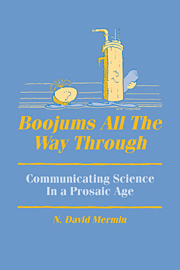Book contents
- Frontmatter
- Contents
- Preface
- I Reflections on the pursuit of physics
- II The quantum theory
- III Relativity
- 17 Cruel Nature: A relativistic tragicomedy
- 18 The amazing many colored Relativity Engine
- 19 Relativistic addition of velocities directly from the constancy of the velocity of light
- 20 Relativity without light
- 21 E = mc2
- IV Mathematical musings
19 - Relativistic addition of velocities directly from the constancy of the velocity of light
Published online by Cambridge University Press: 02 December 2009
- Frontmatter
- Contents
- Preface
- I Reflections on the pursuit of physics
- II The quantum theory
- III Relativity
- 17 Cruel Nature: A relativistic tragicomedy
- 18 The amazing many colored Relativity Engine
- 19 Relativistic addition of velocities directly from the constancy of the velocity of light
- 20 Relativity without light
- 21 E = mc2
- IV Mathematical musings
Summary
Greenwood has given a derivation of the relativistic addition law for parallel velocities that makes no explicit use of the Lorentz transformation equations, relying instead on direct applications of length contraction and time dilation. This kind of approach is necessary in a general education physics course, where more abstract derivations can only obscure the physics. Arguing from the Lorentz transformation in such courses is as inappropriate as trying to teach school children elementary geometrical facts about circles and triangles by starting from their algebraic representations in Cartesian coordinates.
In this spirit I would like to describe another derivation of the addition law that dispenses not only with the Lorentz transformation, but also makes no use of length contraction, time dilation, or the relativity of simultaneity. This argument extracts the result as an immediate consequence of the constancy of the velocity of light.
As in Greenwood's gedanken experiment, we consider a sequence of events taking place on a long straight uniformly moving train. I shall describe all the events from the viewpoint of a frame of reference S in which the train moves parallel to its own length with speed u. All references to speeds, distances, lengths, and times refer to their values in the frame S.
At a certain instant a photon (speed c) and a massive particle (speed w less than c, but greater than u) begin a race from the rear of the train to the front. The photon, of course, wins, taking a time T to reach the front.
- Type
- Chapter
- Information
- Boojums All the Way throughCommunicating Science in a Prosaic Age, pp. 243 - 246Publisher: Cambridge University PressPrint publication year: 1990



